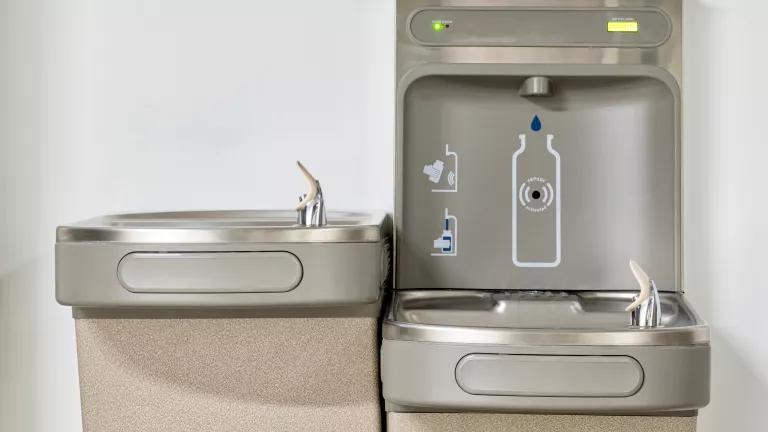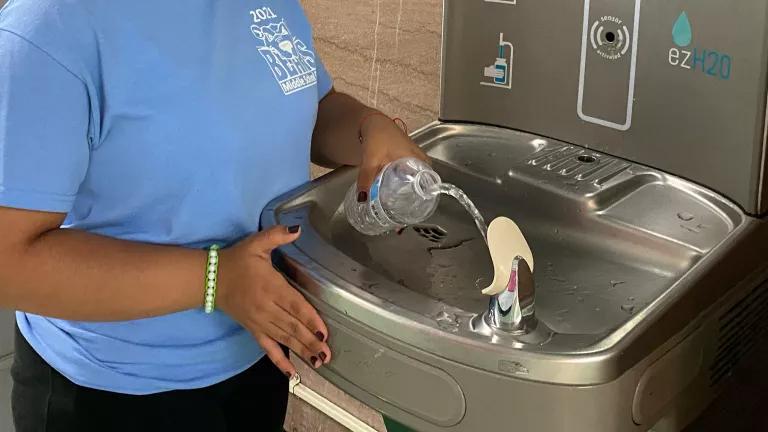Michigan Takes First Step to Address Lead in School Drinking Water
Investments in the Filter First approach provides health protections for children in schools and childcare centers; investments in programs that simply test for lead in drinking water do not.

If enacted, Senate Bill 590 and House Bill 5204, would ensure Michigan students have access to filtered water for drinking and cooking in all public schools.
Last October, the Michigan House and Senate introduced bills designed to get the lead out of drinking water in schools and childcare facilities. By sponsoring NRDC’s Filter First approach, a bipartisan team of lawmakers in both chambers went straight to the solution rather than—as you’ll see below—wasting money on testing for lead in school drinking water.
If enacted, Michigan’s Filter First for schools bills (Senate Bill 590 and House Bill 5104) and the Filter First for childcare bills (Senate Bill 589 and House Bill 5105) would:
- Ensure schools and childcare centers create safe drinking water plans.
- Require schools and childcare centers to install filtered drinking water fountains and point of use filters in certain situations and ensure that non-filtered outlets are removed or not used.
- Provide drinking water to children that does not contain lead because no amount of lead is safe.
- Require schools and childcare centers to test the filtered tap water annually to ensure that filters are functioning properly.
- Ensure that schools and childcare centers communicate with families about the quality of drinking water provided to children.
- Create a fund within state government to make grants to schools as well as childcare centers in low-income communities to cover the cost of additional requirements of the bills.

NRDC's Cyndi Roper testifying before the House Natural Resources and Outdoor Recreation Committee on March 3rd in support of Michigan’s landmark lead in school drinking water legislation, which will protect kids from lead by filtering all water used for drinking and cooking
Elin Betanzo, Safe Water Engineering
The Michigan House Natural Resources and Outdoor Recreation Committee held its first hearing on House Bills 5104 and 5105 on March 3rd, and I testified alongside several of our partners in support of both bills and in favor of funding to implement the legislation.
If you test for lead, you’ll find it.
NRDC’s model Filter First law followed the lead of Washington, D.C. and was developed in the wake of New York State’s landmark 2016 law, which requires lead testing of all water outlets in all public schools. The results provide early lessons for policymakers in New York and elsewhere on the steps they might take to reduce lead in drinking water in schools and childcare facilities. NRDC reviewed the lead in school drinking water occurrence data from New York State. What we found is:
- Around 82 percent of New York public school buildings reported one or more taps that tested above 15 parts per billion (ppb). The safe level of lead in drinking water is zero.
- More than 56 percent of New York public school buildings statewide tested above 15 ppb—the safe level of lead in drinking water is zero—at five percent or more of their water outlets, with a higher rate of taps outside New York City (59%) than inside New York City (51%).
- Almost 2% of the public school buildings statewide found levels above 15 ppb (the safe level of lead in drinking water is zero) for at least half of the outlets tested, with a higher rate outside New York City (2.4%) than in New York City (1.1%)
Closer to home, Indiana conducted a voluntary lead in school drinking water testing program during the 2017-18 school year. Of the more than 1,700 eligible K-12 public schools and educational facilities, 915 (60%) enrolled in the program through which 57,000 samples were collected. Their samples revealed that 62% of schools had at least 1 fixture with lead over 15 ppb, and 7% of schools had more than 10 fixtures (roughly 25%) that sampled above 15 ppb.
Both New York and Indiana found that lead is present in the drinking water if you test for it. But even with the testing results from these states, they don’t have an accurate picture of lead levels in school drinking water due to the variability of lead release at each faucet or fixture; test results at the same water outlet can vary dramatically from one water sample to another.
Filter First: health protective and cost-effective.
Investments in the Filter First approach provides health protections for children in schools and childcare centers; investments in programs that simply test for lead in drinking water do not. And, the good news is that Filter First is the most cost-effective option for ensuring lead-free water in schools. We are still awaiting data for childcare centers, but the expectation is that most of those facilities will only be installing filters on their taps rather than filtration stations as would be the case for schools.
NRDC’s cost analysis is highlighted in the “Michigan Filter First Cost Estimates” document. The bottom line is this: If the legislature enacts and fully funds Filter First for schools in Year One ($54 million), it would actually protect kids from lead in drinking water for roughly two-thirds of what it would cost to test, notify, and replace 40% of the fixtures ($80 million) resulting in a savings of about $26.5 million.
Over a ten-year period, the maintenance and sampling of the filtration stations ($166 million) compared to the cost of testing, notification, and replacing just 40% of the faucets and fixtures ($497 million) is even more favorable: Filter First is about one-third the cost, saving roughly $331 million.
Some have questioned why we don’t just replace all of the lead plumbing and fixtures after testing. There are at least two problems with that approach: 1) most school districts cannot make the immediate large upfront investment necessary to replace all plumbing and fixtures; and 2) even new fixtures, solder, and fittings contain lead. In contrast, we know filters work when they are certified to remove lead and when they’re installed and maintained properly.
These bills have bipartisan sponsorship and support, meaning that Michigan is positioned to become the first state to get the lead out of drinking water in schools and childcare centers, which would move us closer to a lead-free future.



